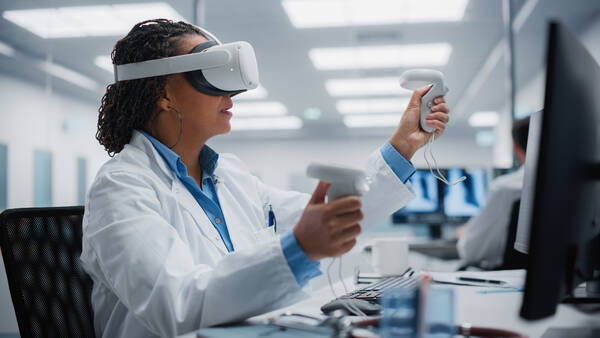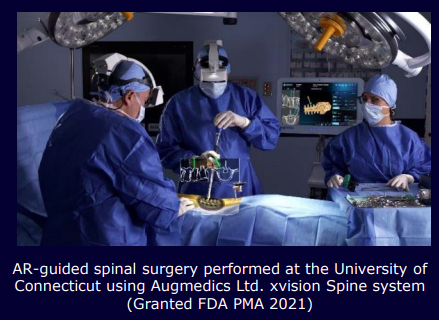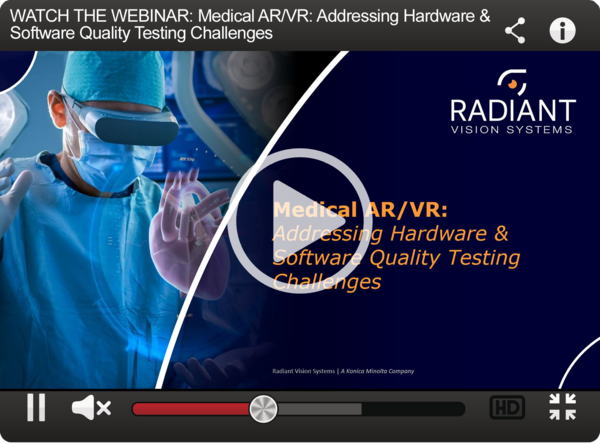Ensuring the Quality of AR/VR Displays and Systems in Medicine
The use of Augmented (AR), Virtual (VR), and Mixed/Merged Reality (MR) in the medical field offers new and exciting potential for enhancing many aspects of healthcare delivery—from VR training to AR-assisted surgeries. As a result, the AR/VR/MR (collectively XR) industry segment has been growing, especially since the early days of the COVID-19 pandemic when no-contact and virtual treatment options became suddenly important. The boom is predicted to continue at a growth rate of 32% CAGR through 2027, reaching nearly $12 billion worldwide.1

The Landscape of Medical AR/VR
This ongoing industry growth is due to the wide range of uses that have emerged for XT technology for both clinicians and patients (see table below). These many applications take advantage of the unique capabilities of XR systems that include three-dimensional data visualization, integrating data from sensor and camera input, and enabling a user to interact with virtual images. Virtual reality provides an immersive experience with images that fill a user’s complete field of vision. Augmented and mixed/merged reality display images on a transparent surface (such as smart glasses) with the background environment still visible. Both of these visual modes have found a place in medical applications.
| Education | Surgery & Treatment | Rehabilitation | Pain Management | Mental Health |
|---|---|---|---|---|
|
|
|
|
|
In this 2022 blog post, we explored some of these applications in detail. For example, doctors are using medical imaging data to create 3-D visualizations of patient anatomy to plan and conduct surgeries. Medical students learn the intricacies of the human heart with an interactive virtual reality model. The immersive nature of virtual reality can help alleviate pain for patients or be a tool for patient rehabilitation/physical therapy.
For people suffering from phobias, trauma, or similar mental-health issues, VR can help people heal. “Therapists can use these devices to completely immerse their patients in a virtual world or augment their real one with digital tools and experiences that enhance their therapy. In addition, VR and AR devices create a safe space for social interactions in this immersive remote therapy experience.”2 In a 2019 blog post, we looked at Medical XR applications for treating chronic pain, brain tumor surgery, recovering from a stroke, and even making the process of getting blood drawn less painful.
Medical XR Quality Considerations
Since the early days of AR/VR systems, painstaking research and testing has been required to ensure safety and comfort for human users. As XR technologies have begun to take hold in the medical industry, new quality considerations arise. Like any medical device or system, it’s vital to ensure the product is effective and safe when used in a treatment modality.
Accordingly, organizations from the International Electrotechnical Commission (IEC) to the U.S. Food and Drug Administration (FDA) and ISO have taken notice. The IEC has released medical AR/VR system performance and testing standards (IEC 63145 publication series). The FDA has established a Medical Extended Reality Program that requires clearance for XR systems. So far, 39 AR/VR systems have been approved for marketing by the FDA. ISO appers to be on the verge of releasing a new standard.

Quality Testing AR/VR Devices for Medical Use
When people’s health is at stake, XR designers and manufacturers need to ensure the quality and performance of their devices and software. Radiant has worked with many of the world’s leading XR companies to measure and quantify system performance accross such parameters as luminance, color (chromaticity), and uniformity.
We’ve developed special optical equipment—including our AV/VR Lens and our XRE Lens Solution—that enable our customers to test a wide variety of systems and components precisely as human users will experience them. Our TrueTest™ TT-ARVR Software is set up to automatically run any of a large library of tests, from distortion and contrast to MTF and uniformity. The XRE Lens system features an electronic lens that can instantly adjust to multiple or variable focal planes, reducing measurement time.
In this webinar, we will discuss AR/VR product testing issues, explain the specifications and tests for medical XR systems, and describe successful approaches to ensure quality. To learn more about the quality considerations for Medical XR systems, and how Radiant solutions can help meet testing needs, watch the webinar: “Medical AR/VR: Addressing the Hardware and Software Quality Test Challenges,” presented November 2023 by GlobalSpec. In it we cover:
- The emerging landscape of medical AR/VR, key applications, trends, and considerations
- The optical quality issues that can affect the performance of hardware devices and the software products that run on them
- Performance and quality parameters such as luminance, color, and contrast for AR/VR devices and applications.
- The latest tools and approaches being used to measure medical and healthcare AR/VR products and enabling display, device, and system makers to improve quality and increase yields.

CITATIONS
- Global AR & VR in Healthcare Market Size, Share, Trends...Industry Forecast (2023 to 2028). Market Data Forecast. March 2023
- Hamilton, J., “Seven therapeutic uses of VR and AR devices.” TechTalks, October 9, 2022.
Join Mailing List
Stay up to date on our latest products, blog content, and events.
Join our Mailing List
